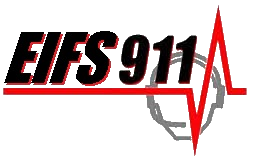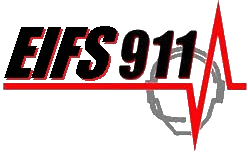Fastening Objects over EIFS Successfully
Whenever an EIFS inspector finds issues with EIFS buildings, several factors are usually considered. Generally, however, the problem is not with the EIFS itself but with something near, on, or through it.
One of the most common causes of problems is how things are attached to the EIFS. This does not include deck beam penetrations or ducts or hose bibs that go through the EIFS but rather everyday things that are attached to the outside of the EIFS, such as light fixtures, downspouts, railings, and so on.
This article will give you some ideas about how to fasten external objects to EIFS successfully properly and also provide warnings about unsuccessful methods.
General Principles
First of all, we must remember that EIFS is a nonstructural material. That is, it does not hold up the building. However, it is attached to a wall system that may hold up the building (this includes studs, which may or may not provide structural support). Logically, the wall structure has much more strength to support things than the EIFS attached to it; therefore, any external attachment should be fastened through the EIFS and directly to the wall structure itself.
Secondly, building elements that are in contact with the EIFS are not necessarily attached to it. Windows and deck beams are typical examples of such features. This second concept may seem simplistic, but a few examples will help elaborate on how commonly these concepts are overlooked.
Heavier Wood Features
As mentioned, major heavy building components should not be attached directly to the EIFS. For example, a large sign should not be attached to the EIFS lamina only, nor should safety items like handrails or fire escapes. These kinds of decisions are not beyond the common sense of most individuals. But what about things like downspouts that can freeze full of water and weigh a lot more than when they were attached? The answer is the same.
Such heavy objects must be attached through the EIFS to something structural behind the EIFS. Sometimes it is possible to use the substrate (the sheathing) for this purpose if it is capable of bearing some load. But more often, we should fasten objects to a primary structural member, such as the studs or a solid wall.
Attaching an object to an EIFS wall is not just a matter of running a big bolt through the EIFS and into the stud. This is not advisable because, in such a situation, a significant load on the bolt will crush the EIFS immediately around the bolt. As a result, the connection will eventually become loose and ineffective. The solution is to embed something in the EIFS, between the outside face of the EIFS lamina and the substrate, which is capable of resisting compression as the fastener being used to attach an external object is tightened.
There are two basic ways to do this. One is to embed a piece of “spacer” material (wood works well) in the EIFS insulation layer as the EIFS insulation is being installed and to attach the external object to the embedded material or through it. If the object is attached to the embedded spacer, then obviously, the spacer itself must be connected to a structural part of the wall. A wood block simply floating loose within the EIFS insulation layer does not provide enough support for an external object of significant weight.
Another way is to put a spacer in the EIFS after the EIFS is installed. This can take the form of a tube (plastic or corrosion-resistant metal) inserted into a hole drilled through the EIFS after the EIFS is in place. Using a carbide-tipped bit, a hole is drilled through the EIFS to the substrate, into which the spacer tube is inserted. The hole and tube are sealed with a sealant, and the fastening bolt used to attach the external object is inserted through the tube.
The first method is a bit more complicated because it requires layout work needed beforehand to be sure the spacer is embedded in the right position within the EIFS for the object to be attached to. This embedding method is also stronger, especially if bolted through. This fastening method is the way to go for heavier objects.
Both of the above two methods are useful for a wide variety of small objects being fastened to the EIFS, but for heavy objects, another approach is needed. In such cases, it is necessary to install a structural bracket attached to the building wall structure, around which the EIFS is installed.
Lightweight Plastics
When dealing with very light objects, such as lightweight plastic address numerals, there is an even simpler solution. Using the example of the address numerals, there is the option of bonding to the surface of the EIFS.
This has several advantages:
- It’s easy. All you need is a structural adhesive.
- There is no penetration through the EIFS lamina. Thus, no sealing is needed.
- It looks good since there are no exposed fasteners.
There are some important considerations with this method, however. We must use a water-resistant synthetic structural adhesive, such as structural grade silicone or urethane, to bond the object to the lamina, as opposed to grout or EIFS adhesive. The reason is that water might get behind the object and freeze or otherwise affect the adhesive, thereby causing the object to fall off. Also, this method is not as advisable with heavy materials such as tile or metal plaques, although it is possible if great care is taken to ensure good bonding. Successful attempts at this have resulted in bands of decorative tile recessed in a shallow aesthetic reveal in the EIFS that were attached using adhesives only. Such designs were carefully looked into by the building designer before being attempted and have been holding up well for years.
Final Considerations
Regardless of what attachment method is used, any penetrations must be sealed. With drainage-type EIFS, this needs to be done to allow the EIFS to retain its drainage capabilities. As all EIFS are proprietary systems, it is invaluable to acquire design input from the manufacturer of the specific EIFS product being used, to ensure that requirements are met for design and warranties. EIFS manufacturers also publish drawings showing various ways to attach objects to EIFS for each of their EIFS products.
With these important considerations in mind and taking care in addressing the particular needs of the specific type of EIFS being used, by consulting the manufacturer’s recommendations, it should be possible to install all varieties of external building features to a building with an EIFS exterior and to have those features securely attached for years to come.



